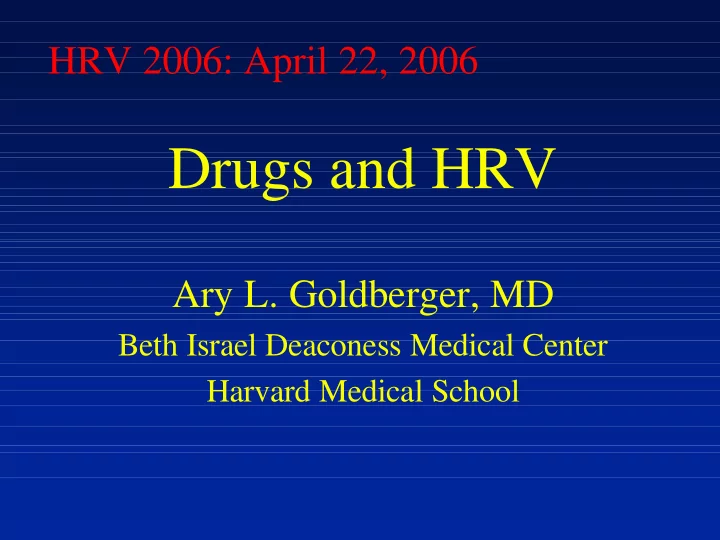

HRV 2006: April 22, 2006 Drugs and HRV Ary L. Goldberger, MD Beth Israel Deaconess Medical Center Harvard Medical School
Objectives • Review basis of drug effects on HRV • Describe confounding factors • Present selected examples: e.g., beta- blockers post-MI; carvedilol in CHF; cocaine; omega-3 fatty acids/fish oil supplements; psychotropics • Discuss future priorities: need for open- access data
Background Notions • Drugs with direct or indirect neuroautonomic effects will affect HRV (esp. atropine-like agents!) • HRV changes may provide useful way to assay for potential beneficial and harmful effects on integrative neuroautonomic function • Pharmacology also useful to probe HRV mechanisms
HRV and Drugs: Background • Many studies in literature (and probably more not published!) • Results sometimes apparently in conflict
HRV & Drug Effects: Caveats and Conflicts • Confounders: age, gender, health vs pathology (type/severity), activity, etc • Data length • Measures used (and not used) • Dosage: amount, timing, route, etc • Acute vs. chronic administration • Drug interactions • Species differences
Some Interesting Cardiac Findings • Drugs that increase vagal/decrease sympathetic effects tend to be salutary (e.g., low dose scopolamine, low dose digoxin or pyridostigmine in CHF; ACEI in CHF • Drugs that decrease vagal/increase sympathetic effects may have harmful/proarrhythmic effects (oral milrinone, cocaine, higher dose digoxin, quinidine, disopyramide, etc)
Voodoo Autonomics • Good vagus vs b-adrenergic
Beta-blocker post-MI Enhanced Recovery of Cardiac Vagal Tone Modulation High Frequency Power Ln (msec 2 ) Ln LF/HF Ratio Baseline 6 weeks Baseline 6 weeks From: Lampert R, et al: Effects of propranolol on recovery of heart rate variability following acute myocardial infarction and relation to outcome in the Beta-Blocker Heart Attack Trial. Am J Cardiol 2003:91:137
Carvedilol in Heart Failure Study Objective • To determine if the ß-blocker (and alpha-1 blocker) carvedilol increases the cardiac modulatory activity of the parasympathetic nervous system in patients with heart failure treated with digoxin and ACE inhibitors Goldsmith RL, Bigger JT, Bloomfield DM, et al. Long-term carvedilol therapy increases parasympathetic nervous system activity in chronic heart failure. Am J Cardiol; 1997; 80:1101.
Patient Population 10 patients (8 males; 38-68 yrs) with CHF � NYHA class III heart failure � LV ejection fraction: 6-34 % (mean 18 %) � VO 2 max (ml/kg/min) 14.8 ±1.2 � Cause of heart failure • Ischemic heart disease 4 • Dilated cardiomyopathy 6 Goldsmith RL, Bigger JT, Bloomfield DM, et al. Am J Cardiol 1997; 80:1101
Methods • Clinically stable, receiving constant dose of digoxin, diuretics and ACE inhibitor for 2 weeks • Baseline evaluation of exercise capacity, LV function, and HRV • Carvedilol 25 mg BID for 4 months • Continued digoxin, diuretics & converting enzyme inhibitors in unchanged doses • Repeat assessment of exercise capacity, LV function and HRV at end of treatment period Goldsmith RL, Bigger JT, Bloomfield DM, et al. Am J Cardiol 1997; 80:1101
Methods (con’t) • 24 hour Holter recordings • Measures of parasympathetic function • Time Domain • rMSSD (root mean square successive difference) • pNN50 (proportion of successive normal RR intervals greater than 50 msec) • Frequency Domain Goldsmith RL et al. Am J Cardiol 1997; 80:1101
Carvedilol in CHF: Time Domain r-MSSD (msecs 2 ) pNN50 (%) 50 20 ∗ ∗ 40 15 30 10 20 5 10 0 0 Baseline Carvedilol Baseline Carvedilol Goldsmith RL, Bigger JT, Bloomfield DM, et al. Am J Cardiol; 1997; 80:1101
Carvedilol in CHF: Frequency Domain 8 ln [HFP] (ms 2 ) 6 4 2 P = 0.001 0 Baseline Carvedilol Goldsmith RL et al. Am J Cardiol 1997; 80:1101
Relation of Baseline Heart Rate and Change in High Frequency Power 2.5 r = 0.73 2.0 ∆ ln [HFP] (ms 2 ) P < 0.05 1.5 . . 1.0 0.5 0.0 500 550 600 650 700 750 800 Baseline R-R (ms) Goldsmith RL et al. Am J Cardiol 1997; 80:1101
Relation of Change in High Frequency Power to Hemodynamic and Clinical Effects of Carvedilol Goldsmith RL et al. Am J Cardiol 1997; 80:1101 2.5 2.5 ∆ ln [HFP] (ms 2 ) ∆ ln [HFP] (ms 2 ) 2.0 2.0 1.5 1.5 1.0 1.0 0.5 0.5 0.0 0.0 -5 0 5 10 15 20 25 -50 0 50 100 150 ∆ Ejection Fraction (%) ∆ Walk (m)
Relation of Change in High Frequency Power to Change in Heart Rate 3.0 ∆ ln [HFP] (ms 2 ) 2.5 2.0 1.5 1.0 r = 0.60 P < 0.07 0.5 0.0 100 200 300 400 500 600 ∆ R-R (ms) Goldsmith RL et al. Am J Cardiol 1997; 80:1101
Carvedilol/CHF: Conclusions Carvedilol increases the activity of the parasympathetic nervous system in patients with moderate to severe chronic heart failure treated with digoxin and ACE inhibitors Goldsmith RL et al. Am J Cardiol 1997; 80:1101
Acute (Intranasal) Cocaine Effects in Healthy Humans Loss of High Frequency Power Cocaine Lidocaine 9 9 Heart rate (beats/mim) 80 80 Ln HF (ln ms 2 ) HR 70 70 HR 7 7 60 60 HF power HF power 50 50 5 5 -10 0 30 60 90 -10 0 30 60 90 Time (min) Time (min) Adapted from : Vongpatanasin W, Taylor JA, Victor, RG. Am J Cardiol 2004;93:385
HRV and Psychotropics Decrease reported with a number of agents: • Tricyclics • Clozapine • Thioridazine SSRIs: variable but usually not prominent effects reported
HRV and Fish Oil Supplements • Omega-3 fatty acid supplements reported to increase physiologic HRV in some, but not all groups • Intriguing results: more data/analyses needed in different subsets; doses • Possible relationship to antiarrhythmic and other reported salutary cardiovascular effects
Future/Current Needs • Open-access databases of drug effects on heart rate dynamics • Only current example: CAST RR-interval subset database on PhysioNet • Ideally, need continuous ECG with detailed metadata: please contribute!
PhysioNet CAST Sub-Study Database http://www.physionet.org/database/crisdb
Recommend
More recommend